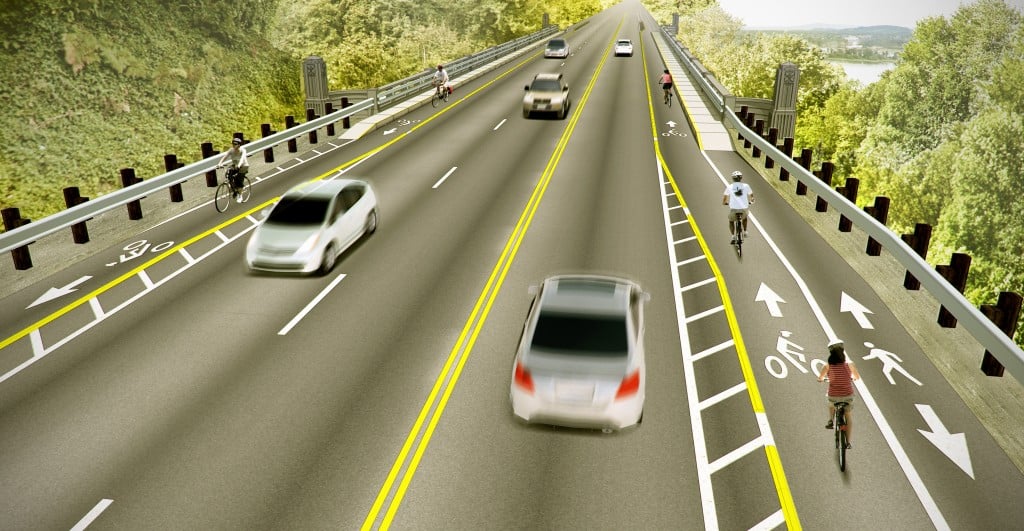
(Graphic by Owen Walz/OwenWalzDesign.com)
If SW Barbur Blvd were redesigned to improve safety and bicycle access — a.k.a. be put on a “road diet” — how would the changes impact traffic? That question is the key sticking point for any big changes for the road.
When this issue made headlines last fall, Transportation Commissioner Steve Novick promised a traffic study as a way to satisfy the concerns of “Barbur road dieters.” Now, the city is outlining its plan for doing so: it’s going to pay close attention to traffic patterns during road work on Barbur this summer.
The Oregon Department of Transportation will conduct the road work, a series of upgrades to two narrow bridges on Barbur, over four months starting April 21. It’ll require closing one lane in each direction on each bridge for about two months each.
In some ways, this work will be similar to the proposal from street safety advocates: that one northbound lane of Barbur across the bridges be repurposed into two dedicated bike lanes. Such a change would remove the need for bikes to merge into a 45 mph auto lane, as they currently do. Last summer, a Metro traffic analyst said bike lanes in this location wouldn’t significantly reduce the capacity of the road, because the traffic signal south of this stretch, at SW Terwilliger, is the chokepoint.
Chris Warner, chief of staff to Portland Transportation Commissioner Steve Novick, sent BikePortland a statement from the city’s transportation bureau this week that the city “will collaborate with ODOT to evaluate what effects the lane closures have on Barbur Blvd traffic flow.”
“We have a good understanding of how ODOT’s contractor will phase the work and what phases of the construction will most closely simulate the effects of a lane reduction,” the city’s statement said. “We plan to collectively summarize this information and share it with the public. We believe outcome of this process will help inform whether a lane reduction merits further study.”
“One thing I hope is measured is diversion to local streets. That is always difficult to forecast, and some real observations would help inform the debate.”
— Chris Monsere, Portland State University professor
We asked Chris Monsere, a traffic engineering professor at Portland State University and nationally respected expert on road diet tests, whether or not a study during construction would accurately mimic real-world conditions if authorities were to convert a general travel lane to a bike lane along this stretch of Barbur.
Only in some ways, Monsere said.
“The construction lane closures might give a general sense of how making the road safer for all users might affect vehicles’ travel times,” Monsere wrote. “However, it will be challenging to make a direct comparison. Construction lane widths, lane merges, and construction activity are likely to have a significant effect on driver behavior/distractions and would make congestion worse than a final, well-designed roadway. There will probably be some really bad days, so hopefully in addition to congestion, detailed records are kept of construction activity so unusual days can be “thrown out.” Other performance measures, like improved safety for all users, will be next to impossible to test in the construction zone. One thing I hope is measured is diversion to local streets. That is always difficult to forecast, and some real observations would help inform the debate.”
ODOT spokesman Don Hamilton downplayed the chance that any findings from the study this summer will lead to any rapid changes on Barbur, saying the data will “be made available to the SW Corridor project to help them do whatever it is they do concerning Barbur.”
The Southwest Corridor project, a Metro-led effort that’s likely to include a proposed rail or rapid bus line along Barbur, isn’t expected to reach the construction phase for years.
When Commissioner Novick decided last fall that this study would be part of the deal surrounding Portland’s sign-off on the Southwest Corridor planning process, advocates from the Bicycle Transportation Alliance and Oregon Walks praised him for the decision. For now, the question is which sorts of data will be gathered — and what it’ll look like once it has been.
Publisher/editor Jonathan Maus reported this story, and wrote it with news editor Michael Andersen.
